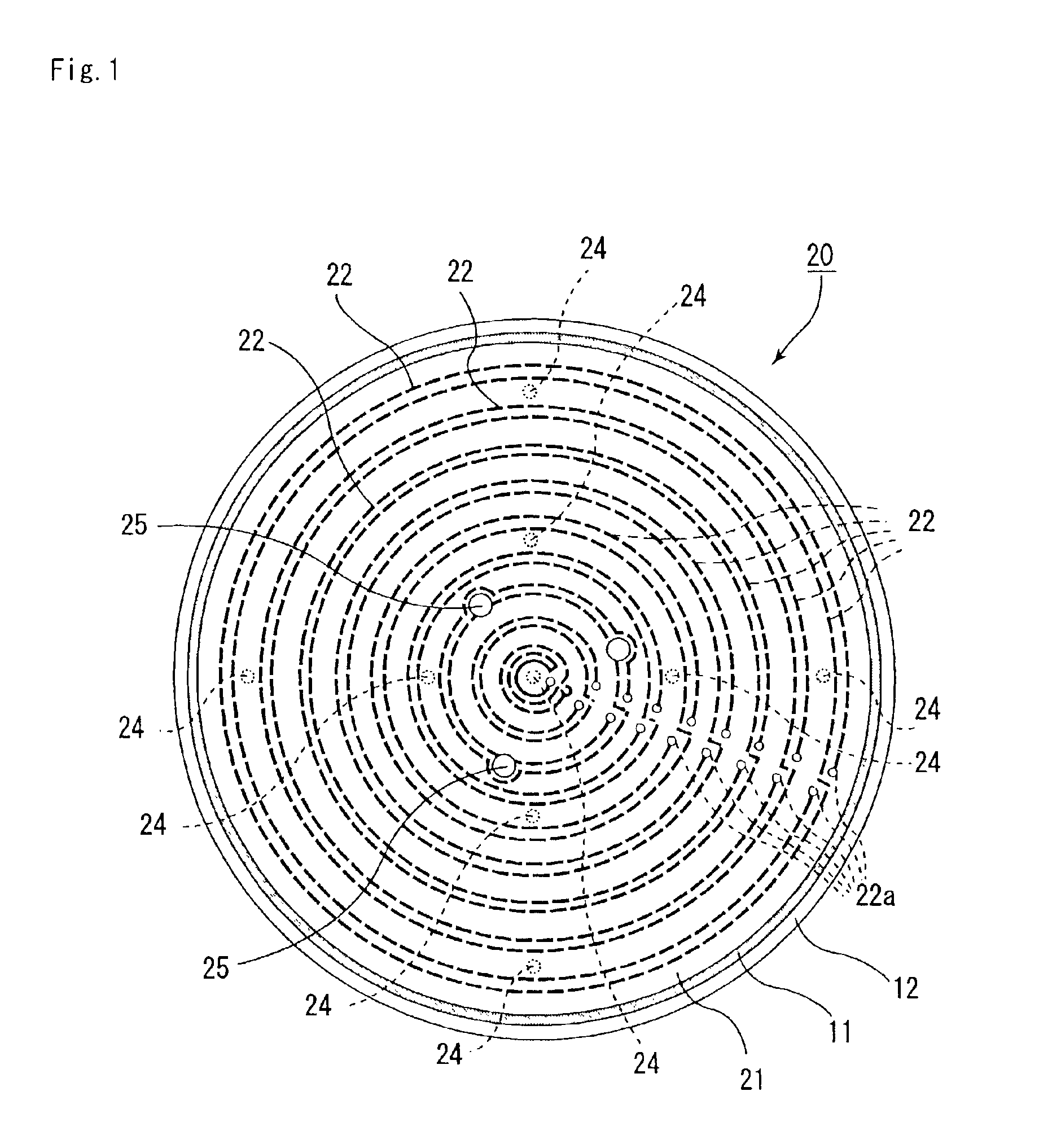Device used to produce or examine semiconductors
a semiconductor and examining device technology, applied in the direction of individual semiconductor device testing, ohmic-resistance heating, instruments, etc., can solve the problems of inability to easily remove the ceramic substrate, interfere with the temperature control of the ceramic substrate, etc., and achieve the effect of preventing hea
- Summary
- Abstract
- Description
- Claims
- Application Information
AI Technical Summary
Benefits of technology
Problems solved by technology
Method used
Image
Examples
example 1
Producing of Ceramic Heater
[0191](1) A composition comprising 100 parts by weight of aluminum nitride powder (made by TOKUYAMA Corp. , average particle diameter: 1.1 μm), 4 parts by weight of yttrium oxide (Y2O3: yttria, average particle diameter: 0.4 μm), 12 parts by weight of acrylic binder, and alcohol was subjected to spray drying to manufacture granular powder.
[0192](2) The granular powder was put in a mold and formed to have a flat plate form to obtain a raw formed body (green).
[0193](3) The raw formed body subjected to the processing treatment was hot-pressed at a temperature: 1800° C. and a pressure: 20 MPa to obtain an aluminum nitride sintered body having a thickness of 3 mm.
[0194]A disk-like body having a diameter of 210 mm was cut from the sintered body to obtain a plate-formed body (ceramic substrate 21) consisting of a ceramic.
[0195]The plate-formed body was subjected to drilling to form a portion for a through hole in which a lifter pin for a silicon wafer was to be i...
example 2
Ceramic Heater (see FIG. 16)
[0204](1) A paste obtained by mixing 100 parts by weight of aluminum nitride powder (made by TOKUYAMA Corp., average particle diameter: 1.1 μm), 4 parts by weight of yttrium oxide (Y2O3: yttria, average particle diameter: 0.4 μm), 11.5 parts by weight of acrylic binder, 0.5 parts by weight of dispersant with 53 parts by weight of alcohol comprising 1-butanol and ethanol was used, and was formed by a doctor blade method to form a green sheet 50 having a thickness of 0.47 mm.
[0205](2) After the green sheet 50 was dried at 80° C. for 5 hours, a portion where a through hole in which a lifter pin for carrying and the like of a silicon wafer was to be inserted, a portion 380 which would be a conductor-filled through hole and the like were formed by punching.
[0206](3) One hundred parts by weight of tungsten carbide particle having an average particle diameter of 1 μm, 3.0 parts by weight of acrylic binder, 3.5 parts by weight of α-Terpineol solvent and 0.3 parts...
example 3
[0216]A ceramic substrate in which a conductor-filled through hole was exposed was produced, and the surface of the exposed conductor-filled through hole was subjected to grinding and the like. Thereafter, the ceramic substrate was subjected to nickel plating and gold plating under the following conditions. Except for these processes, the same processes as those in Example 2 were performed to produce a ceramic heater.
[0217]The ground surface of the conductor-filled through hole was dipped for 20 minutes in an electroless nickel plating solution which had a pH value of 5 and contained 30 g / l of nickel chloride, 10 g / l of sodium hypophosphite, 10 g / l of sodium citrate to form a nickel plating layer 39a having a thickness of 5 μm on the opening part of the conductor-filled through hole. In addition, the resultant structure was dipped in at 93° C. for 23 seconds in an electroless plating bath containing 2 g / l of potassium cyanoaurate, 75 g / l of ammonium chloride, 12 g / l of sodium citrat...
PUM
 Login to View More
Login to View More Abstract
Description
Claims
Application Information
 Login to View More
Login to View More - R&D
- Intellectual Property
- Life Sciences
- Materials
- Tech Scout
- Unparalleled Data Quality
- Higher Quality Content
- 60% Fewer Hallucinations
Browse by: Latest US Patents, China's latest patents, Technical Efficacy Thesaurus, Application Domain, Technology Topic, Popular Technical Reports.
© 2025 PatSnap. All rights reserved.Legal|Privacy policy|Modern Slavery Act Transparency Statement|Sitemap|About US| Contact US: help@patsnap.com



